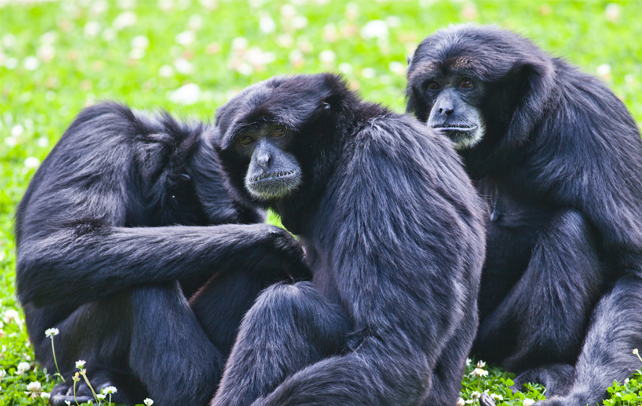Fun Facts About Siamang Gibbon

Large, dark and noisy! Yes, that is how a siamang is. Found mostly in the forests of Southern Asia particularly in Malaysia, Thailand and Sumatra, the siamang gibbon is the largest of all the species of gibbons. Early risers that they are, they start their daily activity at dawn and end it one or two hours before dusk, and retire for the night on the tallest tree they can locate. They are agile—shoulders made in such a way, so as to give them a greater range of motion when swinging—and carefree. Predation is not really a great concern for them, being on top of the trees obviously helps. This swinging helps them to grab the fruits at the end of branch which others are not able to do. A primate like no other! Find out more about this energetic and athletic animal.
Fast Facts
Binomial Name: Symphalangus Syndactylus
Kingdom: Animalia
Phylum: Chordata
Subphylum: Vertebrata
Class: Mammalia
Order: Primates
Family: Hylobatidae
Superfamily: Hominoidea
Genus: Symphalangus
Species: S. syndactylus
Size: 44 to 64 cm
Weight: 4 to13 kg
Life Span: 25 to 30 years in the wild; up to 40 years in captivity
Diet: Omnivores; predominantly fruit and new leaves, but also eats insects, bird eggs and small vertebrates
Range: Malay Peninsula, Indonesia (Sumatra), Thailand
Habitat: Tall trees in primary and secondary rainforests
Age of Sexual Maturity: 5 to 7 years
Gestation Period: 7 to 7.5 months
Average Litter Size: One
Interesting And Fun Facts About Siamang Gibbon
- The siamangs can be divided into two subspecies i.e. the Sumatran siamang and the Malaysian siamang. The former is more fruit eating than the latter; their 60% of diet consists of fruits only.
- A siamang gibbon is tailless with glossy black hair on its body. It also has white markings on its face, hands and feet.
- Siamangs have strong, hook-shaped hands for grasping branches, unusually big arms (of all the gibbon species), larger than their legs, reaching up to 1.5 metres (5 ft) for reaching faraway limbs and powerful legs for moving forward.
- Their shoulders are made in such a way as to help them adapt to greater range of motion when swinging. This striking form of swinging enables them to move at an astounding speed of 56 km per hour.
- Siamangs are the largest of all gibbon species and also the loudest. Siamangs have a large gular sac, which is a pouch on the throat that can be inflated to the size of their head. It is this pouch which enables them to make loud calls.
- The siamangs defend their territory with daily singing rituals which starts around 9 am and last for about an hour. These loud songs can be heard up to 3.2 kilometres away through the forests.
- Siamangs’ eats at least 160 species of plants; their most favourite food is the fruits and the figs. However, they occasionally feed on insects, bird eggs and small vertebrates.
- Siamang gibbon are monogamous; one of the few primates to form lifelong pairs. They live in groups of family which consists of four to six individuals with an average home range of 23 hectares.
- The group consists of a dominant male, dominant female, offspring, infants, and sometimes a sub-adult. This sub-adult leaves the group after reaching 6 to 8 years of age.
- 50% of their waking time is spent resting. Generally, they use a tall tree for the purpose, either lying on their back or on their stomach.
- Siamangs have a highly developed brain, just like all other primates.
- For siamangs, grooming is an important social activity. An adult, on an average, grooms for about 15 minutes per day and he also grooms a female and sub adult males.
- The gestation period of a female siamang is around 7 to 7.5 months. Every two or three years a new offspring is born and the female rarely give birth to more than ten offspring in her lifetime.
- Baby siamangs are born hairless but are soon covered with soft hair, and weigh just 6 ounces, which is less than a cup of water.
- Baby siamangs are weaned when they become one year old; they stay with their mother till they are 5-7 years of age. The young one then go and start their own family.
- Siamang males tend to offer more paternal care to an infant, especially after it is about 8 months old.
- Siamangs cannot swim and therefore, avoid water.
- Each pair, male and female, creates a unique song of their own and they sing it to one another.
- Siamangs have been listed under ‘Endangered’ category by the International Union for Conservation of Nature. Their survival is directly related to the conservation of their natural habitat.









